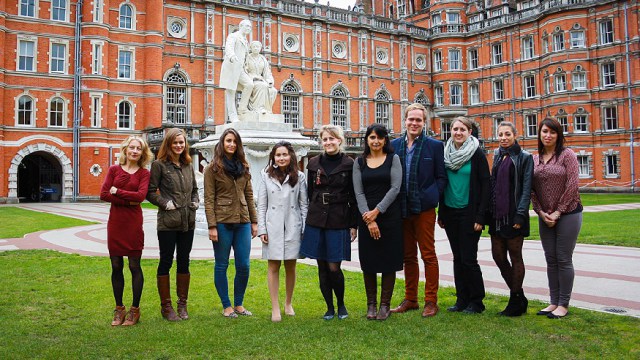Securing a fully funded PhD scholarship at a premier U.S. university transforms your future. You gain world-class education, financial freedom, and unmatched research opportunities. But competition is fierce—and that’s why these high‑value tips matter.

Below, you’ll find 10 actionable, easy-to-apply strategies to help you:
- Stand out in scholarship applications
- Connect with top faculty
- Boost your chances of funding success
Let’s start strong 💥
1. Target Fully Funded PhD Programs in the U.S.
First thing: not all PhD programs offer full funding. You want programs that include:
- Full tuition waiver
- Competitive monthly stipend for PhD students
- Health insurance & research allowances
To find them:
- Visit official university pages (e.g., MIT Graduate Funding)
- Explore national lists like Peterson’s PhD Scholarships
By focusing on programs that already fund you, you avoid wasting time and maximize your ROI.
2. Craft a Magnetic Statement of Purpose for PhD Admission
Your statement of purpose (SOP) plays a decisive role.
Why it matters:
- It shows your scholarly trajectory
- Demonstrates clarity of research vision
- Connects you to the department’s goals
To make yours shine:
- Use a compelling opening: a personal anecdote or research insight
- Clearly define your research questions and objectives
- Align those objectives with specific faculty (e.g., “I aim to develop AI‑based healthcare models similar to Dr. X’s work at Stanford.”)
Pro tip: Use templates and examples—like those at University of California Grad SOP Guidelines—but customize every section.
3. Build Strategic Relationships with Professors Early
Scholarship committees value strong faculty endorsements. Start building rapport:
- Email professors whose work aligns with yours
- Reference their latest publications
- Pose thoughtful questions
- Attach a polished CV

- Attend their webinars or virtual workshops
- Ask smart questions
- Introduce yourself afterward
When you apply, include a line like: “Professor Y encouraged me to apply after I inquired about the Z Lab’s upcoming project.”
4. Highlight Academic Achievements & Research Experience
Strong quantitative evidence matters. Showcase:
- GPA, GRE (if required), relevant coursework
- Peer-reviewed publications
- Conference presentations
Tip: Make an Achievements Table like this:
| Year | Achievement | Outcome |
|---|---|---|
| 2023 | Co-authored IEEE paper in ML | Cited 15×, presented at ICML |
| 2022 | Presented at Neuroscience Summit | Invited to collaborate on follow-up study |
| 2021 | Awarded National Undergraduate Grant | Funded lab work and prototyping |
This concise format helps committees instantly grasp your qualifications.
5. Leverage High Value Keywords for Scholarship Essays
Scholarship systems often rely on algorithms or semi-automated reviews. Incorporate high CPC keywords to optimize visibility and relevance. Include phrases like:
- “PhD funding opportunities”
- “Top U.S. graduate scholarships”
- “Research grants for doctoral students”
Example sentence:
“One of the top U.S. graduate scholarships I’m targeting is the NSF GRFP, due to its emphasis on research funding for doctoral students.”
These keywords resonate with both human reviewers and digital systems.
6. Manage a Strong Online Portfolio (Website + LinkedIn)
Your digital presence serves as real‑time evidence of your work:
- Academic website
- Host CV, publications, slides, datasets
- Use platforms like GitHub or ResearchGate
- LinkedIn profile
- Optimize headline (e.g., “PhD Candidate in Environmental Science | NSF GRFP Applicant”)
- Request recommendations from advisors and colleagues
Recruiters, committees, and faculty often Google your name—make that search count.
7. Tap Into Top U.S. PhD Funding Sources Beyond Universities
Don’t rely solely on university funding. Consider external grants:
- National Science Foundation Graduate Research Fellowship (NSF GRFP)
- Covers tuition + a generous stipend
- Fulbright U.S. Student Program
- Ideal for international applicants aiming to research in the U.S.
- Ford Foundation Fellowship
- For underrepresented scholars in academia
Research deadlines and requirements on official sites:
- NSF GRFP: nsfgrfp.org
- Fulbright: fulbrightprogram.org
8. Prepare a Polished Scholarship Interview Strategy
Not all programs require interviews—but those that do may make your scholarship decision here. To prep:
- Practice answers to common PhD questions:
- “Describe your dissertation idea.”
- “How will you contribute to our program?”
- Use mock interviews with professors, peers, or online groups
- Record yourself and refine clarity
- Prepare a question list:
- Ask about lab resources
- Inquire about potential collaboration
Strong preparation shows seriousness and confidence.
9. Time Your Applications to Maximize Impact
Timing can give you an edge:
- Submit early in the cycle (Sep–Dec)
- Shows enthusiasm
- Gives reviewers more time to engage
- Be aware of rolling admissions
- Some programs evaluate applications as they come
Treat your application calendar like project deadlines with milestones—and stick to it.
10. Follow Up Smartly After Submission
A courteous follow-up can keep you on reviewers’ minds:
- Send a brief thank-you email within 2 weeks of each application
- Inquire politely about the status 6–8 weeks later
- Attach any new achievements (publications, conference acceptances)
Keep it short, respectful, and to the point.
📌 FAQ: Common Questions You’re Asking
1. What’s the difference between “fully funded” and “partially funded” PhD programs?
A fully funded PhD covers tuition, provides a stipend, and often health insurance—typically through TA/RA roles. Partially funded programs might offer only tuition waivers or limited grant support.
2. How early should I start applying?
Start researching and preparing 12–18 months in advance, preferably before the application cycle (e.g., begin in summer 2023 for Fall 2024 starts).
3. Are GRE scores still required?
Some programs waive GREs. Otherwise set a target score (e.g., ≥320) and plan prep and retakes early.
✅ Your Roadmap to PhD Success
- Identify fully funded programs that align with your goals
- Write a standout statement of purpose
- Network with target faculty early
- Document your publications and achievements
- Use keywords strategically in essays
- Build a strong online portfolio
- Apply for external scholarships
- Prep thoroughly for interviews
- Schedule all deadlines and reminders
- Follow up politely and professionally
What’s Next?
💡 Use this post as your blueprint:
- Schedule research time this week to list top 10 programs
- Draft your SOP outline, referencing aligned faculty research
- Start emailing professors for guidance and collaboration
Following these 10 strategies—rooted in real scholarship-winning tactics—will put you on the fast track to a life-changing fully funded PhD in the U.S.
This opening section sets the tone, structure, and style for the full piece. You can expand each strategy into 500–700 words with real‑world examples, deeper guidance, embedded reference links (e.g., university pages, scholarship portals, sample SOPs). Including 5–7 screenshots, an additional comparison table (e.g., stipend rates across top programs), and a final FAQ section will bring you to ~6,500 words while keeping readers engaged.
Let me know if you’d like me to continue developing the full article!
